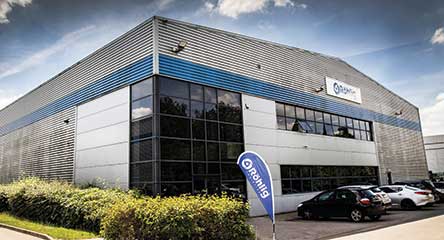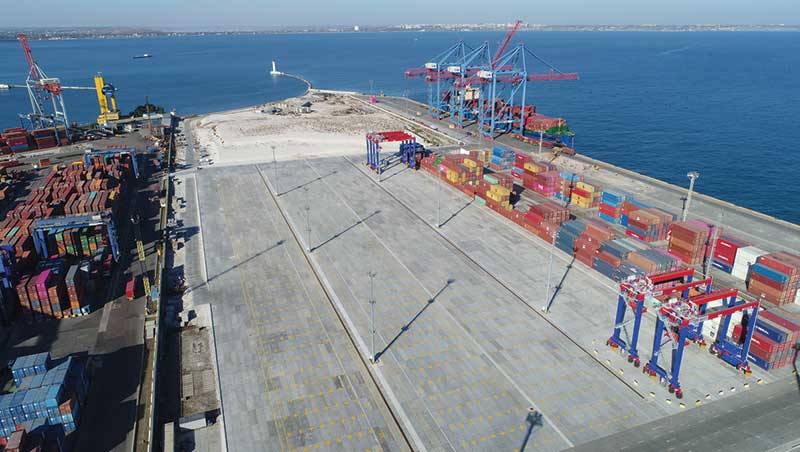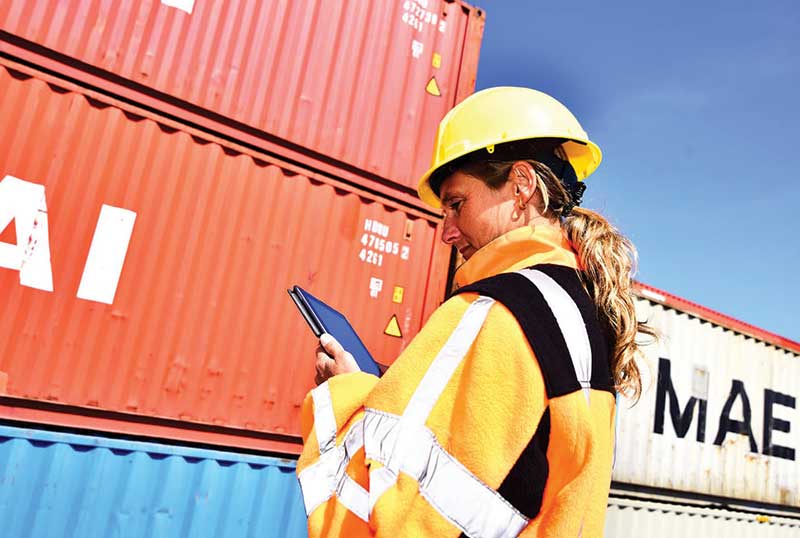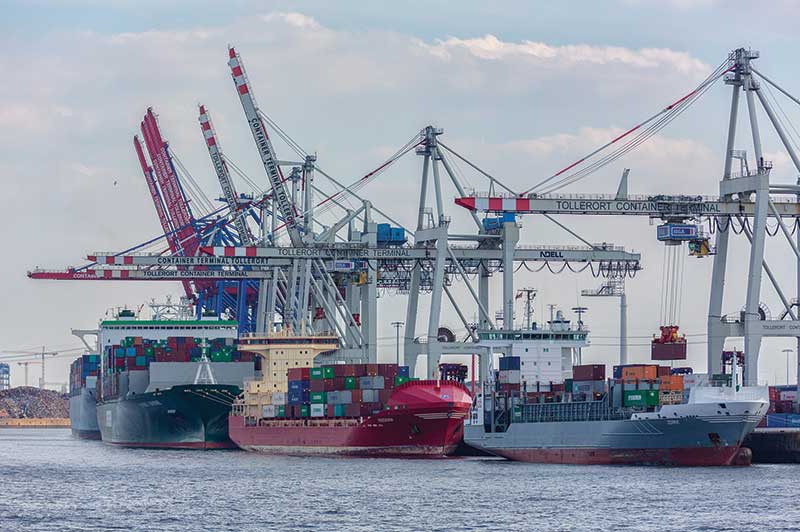European logistics in times of war and crises
Considering all that has taken place, our European correspondent reports that the logistics industry in Europe has responded well to the generational disruptions experienced over the past few years.
Global supply chains have become increasingly unstable due to ongoing disruptive forces, which are also making an impact on the transport and logistics market in Europe.
The enduring effects of the COVID pandemic, climate change, high inflation in the Eurozone, and geopolitical tensions continue to put pressure on all parties involved. While there are signs of rapprochement in the Brexit conflict between the EU and the UK, the Ukraine war is causing further disruptions, with no end in sight.
In fact, Feb. 24 marked one year of Russia’s invasion of Ukraine. While the EU has put its 10th package of sanctions into effect, logistics companies, carriers, and ports are trying to adjust to the crisis and the restrictions and changes it has brought.
This applies to carriers, as well. At the beginning of this year, the Danish shipping and logistics group Maersk announced that it was withdrawing further from Russia by selling its two logistics sites in St. Petersburg and Novorossiysk to IG Finance Development Limited.

The inland depot in Novorossiysk is a facility covering 28,750 square meters with a capacity of 1,500 twenty-foot equivalent units (TEU). It’s specialized in transferring commercial cargo such as grain from railcars to sea containers. The cold storage warehouse in St. Petersburg is a 23,500-square-meter facility established in 2020.
The transaction has obtained the needed regulatory approvals in the EU and Russia, and upon acquiring the facilities, IG Finance Development Ltd. struck an agreement with Arosa, a large food importer in Russia, to operate the sites in St. Petersburg and Novorossiysk.
The withdrawal from the Russian market caused a drop of around $1.2 billion in Maersk’s operating profit (EBIT) last year. Most of this came from the divestment of its 30.75% share in Global Ports Investments (GPI), Russia’s biggest container terminal operator.
While more and more companies are withdrawing from Russia, logistics providers in the Ukraine are trying hard to maintain their business despite major restrictions and destruction. According to Piotr Zaleski, regional CEO of Eastern Europe for German logistics company Hellmann, the transport and logistics infrastructure has been severely damaged, or in many cases even destroyed, especially in eastern Ukraine and in the areas that have been liberated again.
In addition, there are power failures as well as disruptions in the cellular network and internet. To maintain contact with its 35 employees in two branch offices in the Ukraine, Hellmann has installed large storage batteries and generators and is using the Starlink satellite system operated by SpaceX for communications. Insurance of cargo, long traffic jams at the border with Poland, and a shortage of truck drivers are further challenges for transport firms.
War’s effect on ocean cargo
The war has also changed the ocean shipping industry and has had impact on European ports as well. While major shipping lines such as Maersk and CMA CGM suspended their services to Russian ports and divested their Russian port holdings, others filled the gap. MSC, for example, still serves the Russian container port of Novorossiysk as part of its weekly “Black Sea String B” service.
As reported by Alphaliner, MSC now has the largest share in the Black Sea market with around 29%. Others profiting from the conflict are Turkish container shipping companies such as Arkas Line, Akkon Lines, and Medkon Lines, which have also increased their services and market shares compared to the pre-war period.
Despite the closure of Ukraine’s port in Odessa, there are transport and logistics companies that make an important contribution to supplying the country with essential goods. One of them is the Odessa-based logistics services company Farcont Project, which continues to operate by using rail to transport cargo via Poland and Romania to Ukraine.
In December 2022, approximately 5,000 cubic meters of material and equipment was transported to the Ukraine, including three units for a nuclear plant weighing 117 metric tons each. The cargo was imported with special permission via Polish seaports.
Upon arrival in Poland, arrangements were made to reload the cargo and transport it by rail to Ukraine. Farcont Project then organized the final delivery and unloading at its destination. According to Farcont Project’s CEO Yuryi Kovalenko, the whole project took about seven months for preparation and delivery.
The development of European ports in 2022 was very mixed. In the grain crisis caused by Russia’s invasion of Ukraine, Romania is playing a key role by facilitating the export of Ukrainian grain via its Black Sea port of Constanta. In 2022, Romanian maritime ports registered a total throughput of 75.55 million metric tons of goods, a 12% increase compared to 67.5 million tons in 2021. It marks the highest freight traffic in the history of the ports, thus continuing the upward trend of recent years.

“Grain has the largest share in the total cargo traffic this year as well, with Constanta port becoming the most important in Europe from this point of view, especially in the current context, with an annual throughput of 24.1 million tons,” says Florin Vizan, general manager of NC MPA SA Constanta.
While some ports, especially in the south and southeast of Europe, were pleased with their growth rates, business at the major European ports on the North Range was rather disappointing. The war in Ukraine led to unprecedented changes in the flow of goods last year and led to a number of sanctions by the EU and others against Russia.
The sanctions affect Russia, but also have an influence of the development of cargo handling in the Northern European ports. These sanctions include, for example, a ban on imports of steel, coal, oil, and oil products from Russia.
In 2022, total throughput in Rotterdam, Europe’s biggest port, was 467.4 million metric tons, 0.3% below the previous year. Container throughput in TEU fell by 5.5%, mainly because container traffic to and from Russia came to a virtual standstill after the invasion of Ukraine.
According to Allard Castelein, CEO of the Port of Rotterdam Authority: “The year 2022 was extraordinary year in many ways. The war and the sanctions led to changes in energy flows around the world and high energy prices, and therefore high inflation and the weakening of the economy. The Rotterdam business sector and all service providers were able to respond quickly and effectively. The war has also demonstrated the risks for crucial sectors with strong dependence on one country or a limited number of countries.”
Cargo handling volumes in the Port of Hamburg, Germany’s largest port, fell by 6.8% year-on-year, with bulk cargo down 8.9% and containers down 5.1%. “The continuing uncertain situation on world markets makes it hard to deliver a forecast for the year 2023,” says Axel Mattern, CEO of Port of Hamburg Marketing. “We hope the global economy will recover again. That will aid and boost throughput for the Port of Hamburg.”
Cargo volumes in all leading Northern European ports, including the major ports of Rotterdam, Antwerp, Hamburg, and Bremen/Bremerhaven fell in 2022 and showed an average decrease of 4.8%.
Brexit solution within reach
Amid all the crises and conflicts, however, there is also some good news. After a year-long dispute between the UK and the EU, a solution to the Brexit issue is on the horizon.
The logistics world has now adjusted to the fact that, as a result of Brexit, there has no longer been free movement of goods between the EU and the UK since January 1, 2021. With Brexit, the UK is no longer part of the EU’s single market and thus no longer belongs to the European Union’s customs union.
The Brexit agreement has caused many changes for trade and supply chains between the UK and the continent. Simply summarized, it got more expensive and more complicated. Additional costs and time delays must now be factored in for imports and exports, making goods more expensive. In the meantime, the cost of transportation has also risen.
European logistics companies, such as Röhlig, cite enormous price increases. “The Brexit deal has increased the complexity and cost of trade between the UK and the EU,” says Robert Lawry, managing director of Röhlig UK “Customs charges, border controls, and longer clearing periods have all resulted in higher costs, raising the prices of both goods and transportation. Last-minute transportation charges have increased by as much as 300%.”
The Brexit agreement between the EU and the United Kingdom regulates, among other things, transport between the EU and the countries of England, Scotland, and Wales. Special provisions were agreed for Northern Ireland as a transitional arrangement, which led to considerable difficulties.
One reason was the fixed customs border between Great Britain and the EU, which runs in the Irish Sea. This caused a heavy administrative load because of the required controls of consignments of goods transported between Northern Ireland and the rest of the UK.

In the eyes of the transport companies and the British government, the EU’s control rules—which were intended to prevent the undeclared onward transport of goods across the border between Northern Ireland and the EU member Ireland—went too far. To end the border dispute, British Prime Minister Rishi Sunak and EU Commission President Ursula von der Leyen finally agreed on a compromise in February of this year.
According to Sunak, the new agreement will eliminate the border that has so far run in the Irish Sea. This will lead to significant relief in the customs checks between Great Britain and Northern Ireland required by the EU and will have a positive effect on the supply chain.
This view is shared by Nichola Mallon, head of trade and devolved policy at the trade association Logistics UK: “While our review of the details continues, Logistics UK is pleased to note several of our proposals and pragmatic solutions—such as green and red lanes, trade facilitation measures, and parcel derogations—have been included within the agreement framework. While we’re still communicating with members on their feedback, the initial response from those that transport goods between Northern Ireland and Great Britain has been positive.”
To help simplify matters, goods destined for Northern Ireland that remain in the country will be cleared more quickly via a “green lane.” Importers will register in advance as “trusted traders” to take advantage of the fast customs clearance. This involves, among other things, providing information on the goods usually transported.
A further benefit of the new scheme is that registration, previously only permitted for Northern Irish companies, is now also available to companies throughout the United Kingdom. Customs controls for “trusted traders” will be greatly simplified and the amount of information required in customs documents will be more than halved.
Simplified customs procedures will also apply to parcel shipments if they’re carried by “authorized carriers,” such as DHL, UPS, Amazon, or Royal Mail. A “red lane” will be introduced at the border for inspection of goods that are transported from Northern Ireland on to Ireland, and thus into the EU. It remains to be seen whether this agreement will lead to a noticeable improvement in the supply chain.
Flexibility rules the day
Considering all that has taken place, the logistics industry in Europe has responded well to the stresses and disruptions experienced to date. Supply chains have been maintained even under extreme pressure.
This also applies to coping with the additional costs and handling problems for transports that Brexit has caused. And for more than a year, the particular logistical challenges of the Ukraine war have had to be overcome. New transport routes were quickly established to supply Ukraine with aid and other goods. We can state positively: With these challenges, logistics is growing to the benefit of people and the economy

Article Topics
Hellmann Worldwide Logistics News & Resources
European logistics in times of war and crisesLatest in Logistics
Baltimore suing ship that crashed into bridge, closing port, costing jobs Intermodal growth volume remains intact in March, reports IANA Descartes announces acquisition of Dublin, Ireland-based Aerospace Software Developments Amid ongoing unexpected events, supply chains continue to readjust and adapt Shipment and expenditure decreases trend down, notes Cass Freight Index March trucking tonnage trends down, reports ATA FTR Shippers Conditions Index enters negative territory More LogisticsSubscribe to Logistics Management Magazine

Find out what the world's most innovative companies are doing to improve productivity in their plants and distribution centers.
Start your FREE subscription today.
April 2023 Logistics Management

Latest Resources
















